ARCH3009 Semester 1: Architecture Literature Review and Critique
VerifiedAdded on 2023/01/17
|10
|2656
|29
Literature Review
AI Summary
This literature review examines the integration of luxury and sustainability in architecture, focusing on Japanese postmodern designs. The paper analyzes the historical context and design principles of Tokyo Midtown and the National Art Center, highlighting how these buildings incorporate sustainable practices while maintaining a sense of luxury and historical relevance. The review critiques the design elements, urban planning, and cultural impact of these buildings, considering the interplay between public and private spaces, resource efficiency, and the promotion of social interaction. The analysis explores the use of green spaces, water features, and the incorporation of Japanese heritage to create sustainable and aesthetically pleasing environments. The review also delves into the role of technology and design in achieving both comfort and environmental responsibility, providing a comprehensive overview of the challenges and successes in contemporary architecture.
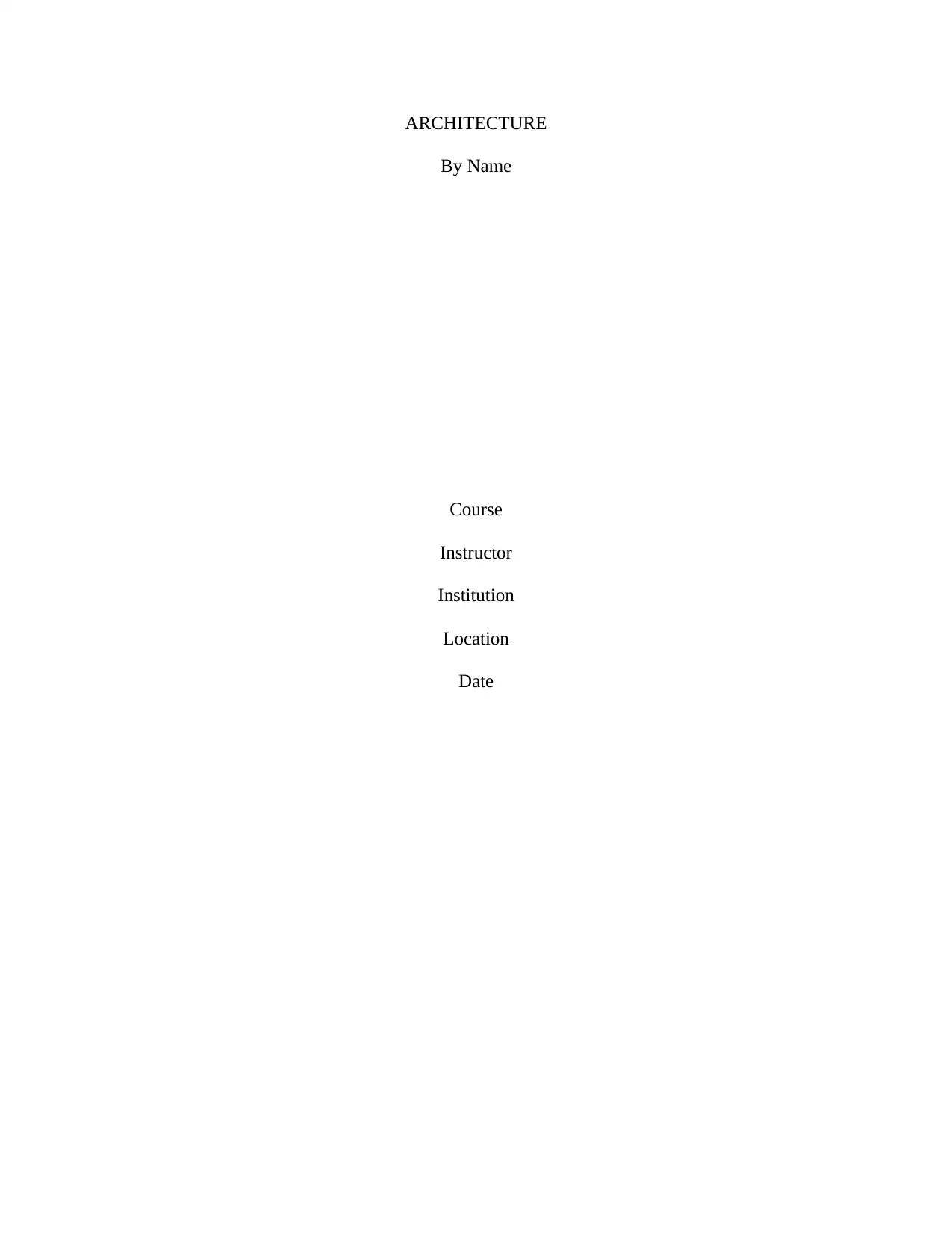
ARCHITECTURE
By Name
Course
Instructor
Institution
Location
Date
By Name
Course
Instructor
Institution
Location
Date
Paraphrase This Document
Need a fresh take? Get an instant paraphrase of this document with our AI Paraphraser
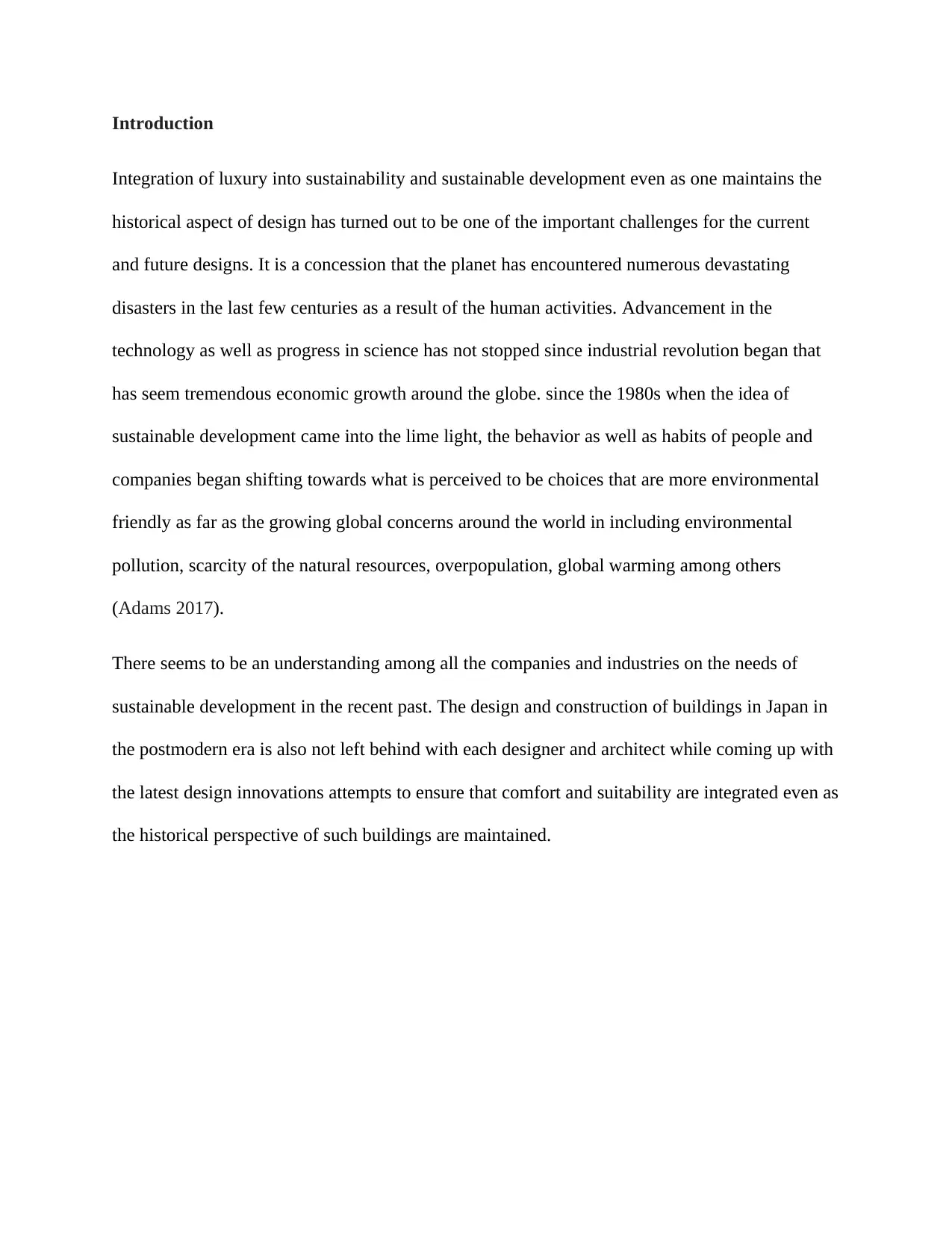
Introduction
Integration of luxury into sustainability and sustainable development even as one maintains the
historical aspect of design has turned out to be one of the important challenges for the current
and future designs. It is a concession that the planet has encountered numerous devastating
disasters in the last few centuries as a result of the human activities. Advancement in the
technology as well as progress in science has not stopped since industrial revolution began that
has seem tremendous economic growth around the globe. since the 1980s when the idea of
sustainable development came into the lime light, the behavior as well as habits of people and
companies began shifting towards what is perceived to be choices that are more environmental
friendly as far as the growing global concerns around the world in including environmental
pollution, scarcity of the natural resources, overpopulation, global warming among others
(Adams 2017).
There seems to be an understanding among all the companies and industries on the needs of
sustainable development in the recent past. The design and construction of buildings in Japan in
the postmodern era is also not left behind with each designer and architect while coming up with
the latest design innovations attempts to ensure that comfort and suitability are integrated even as
the historical perspective of such buildings are maintained.
Integration of luxury into sustainability and sustainable development even as one maintains the
historical aspect of design has turned out to be one of the important challenges for the current
and future designs. It is a concession that the planet has encountered numerous devastating
disasters in the last few centuries as a result of the human activities. Advancement in the
technology as well as progress in science has not stopped since industrial revolution began that
has seem tremendous economic growth around the globe. since the 1980s when the idea of
sustainable development came into the lime light, the behavior as well as habits of people and
companies began shifting towards what is perceived to be choices that are more environmental
friendly as far as the growing global concerns around the world in including environmental
pollution, scarcity of the natural resources, overpopulation, global warming among others
(Adams 2017).
There seems to be an understanding among all the companies and industries on the needs of
sustainable development in the recent past. The design and construction of buildings in Japan in
the postmodern era is also not left behind with each designer and architect while coming up with
the latest design innovations attempts to ensure that comfort and suitability are integrated even as
the historical perspective of such buildings are maintained.
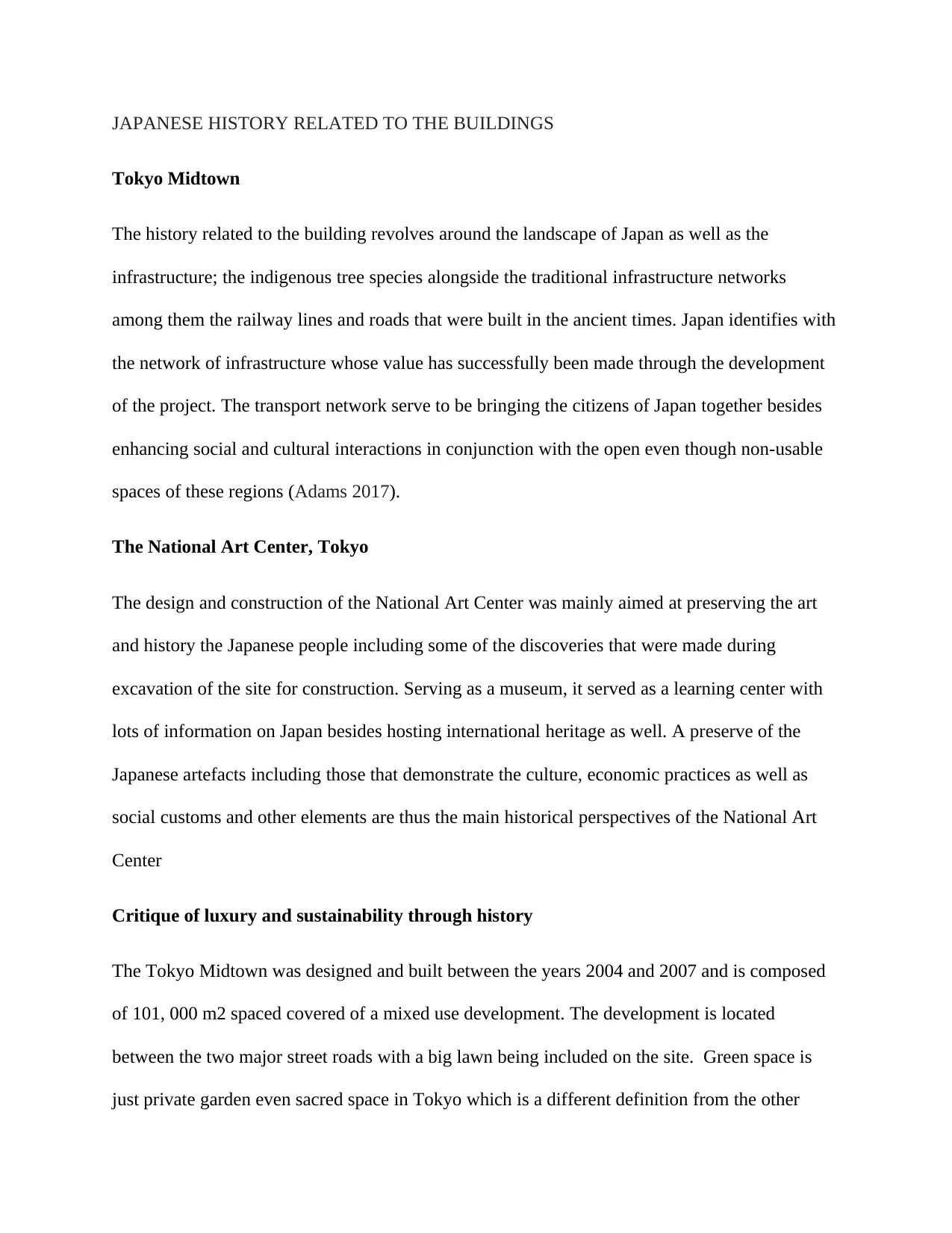
JAPANESE HISTORY RELATED TO THE BUILDINGS
Tokyo Midtown
The history related to the building revolves around the landscape of Japan as well as the
infrastructure; the indigenous tree species alongside the traditional infrastructure networks
among them the railway lines and roads that were built in the ancient times. Japan identifies with
the network of infrastructure whose value has successfully been made through the development
of the project. The transport network serve to be bringing the citizens of Japan together besides
enhancing social and cultural interactions in conjunction with the open even though non-usable
spaces of these regions (Adams 2017).
The National Art Center, Tokyo
The design and construction of the National Art Center was mainly aimed at preserving the art
and history the Japanese people including some of the discoveries that were made during
excavation of the site for construction. Serving as a museum, it served as a learning center with
lots of information on Japan besides hosting international heritage as well. A preserve of the
Japanese artefacts including those that demonstrate the culture, economic practices as well as
social customs and other elements are thus the main historical perspectives of the National Art
Center
Critique of luxury and sustainability through history
The Tokyo Midtown was designed and built between the years 2004 and 2007 and is composed
of 101, 000 m2 spaced covered of a mixed use development. The development is located
between the two major street roads with a big lawn being included on the site. Green space is
just private garden even sacred space in Tokyo which is a different definition from the other
Tokyo Midtown
The history related to the building revolves around the landscape of Japan as well as the
infrastructure; the indigenous tree species alongside the traditional infrastructure networks
among them the railway lines and roads that were built in the ancient times. Japan identifies with
the network of infrastructure whose value has successfully been made through the development
of the project. The transport network serve to be bringing the citizens of Japan together besides
enhancing social and cultural interactions in conjunction with the open even though non-usable
spaces of these regions (Adams 2017).
The National Art Center, Tokyo
The design and construction of the National Art Center was mainly aimed at preserving the art
and history the Japanese people including some of the discoveries that were made during
excavation of the site for construction. Serving as a museum, it served as a learning center with
lots of information on Japan besides hosting international heritage as well. A preserve of the
Japanese artefacts including those that demonstrate the culture, economic practices as well as
social customs and other elements are thus the main historical perspectives of the National Art
Center
Critique of luxury and sustainability through history
The Tokyo Midtown was designed and built between the years 2004 and 2007 and is composed
of 101, 000 m2 spaced covered of a mixed use development. The development is located
between the two major street roads with a big lawn being included on the site. Green space is
just private garden even sacred space in Tokyo which is a different definition from the other
⊘ This is a preview!⊘
Do you want full access?
Subscribe today to unlock all pages.

Trusted by 1+ million students worldwide
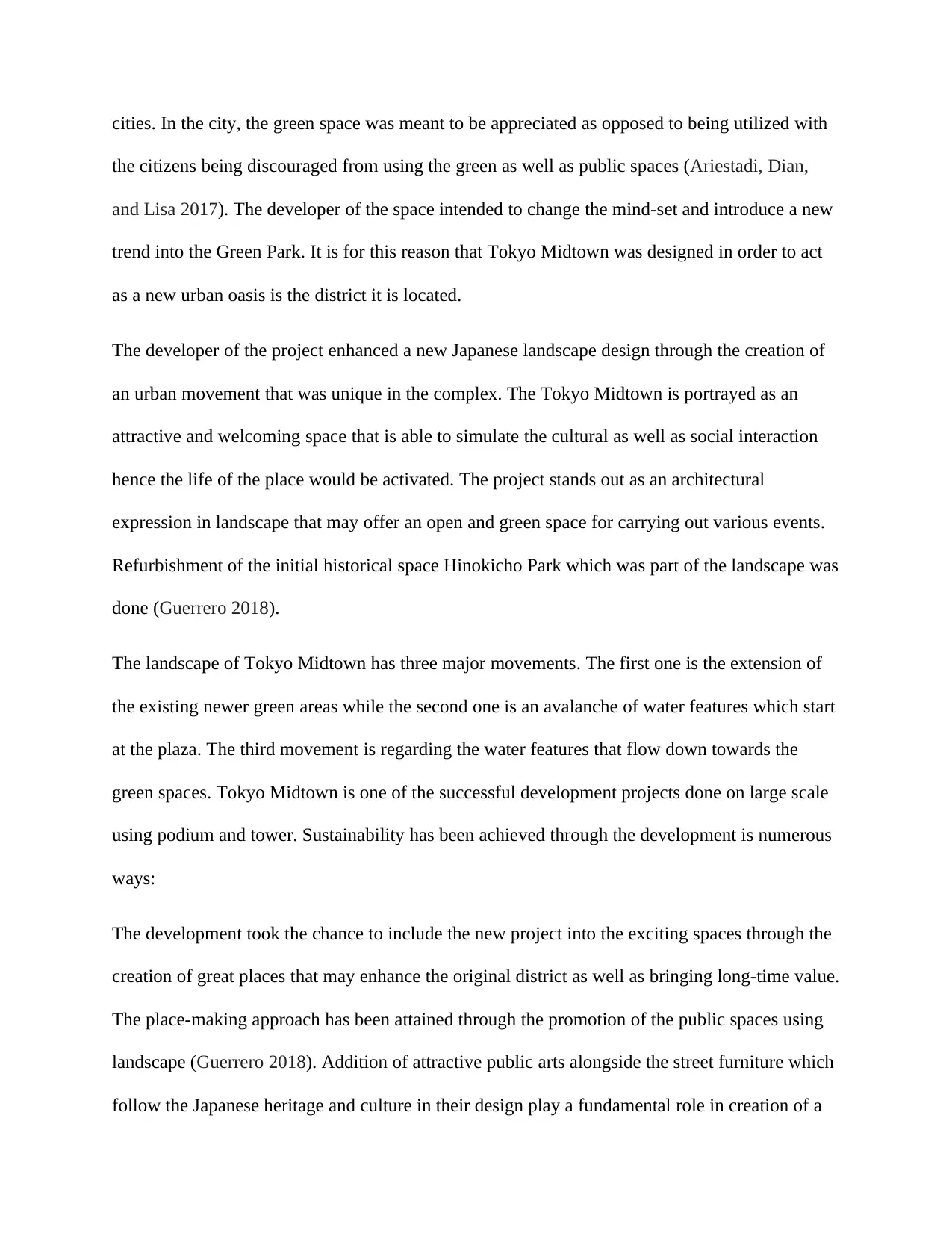
cities. In the city, the green space was meant to be appreciated as opposed to being utilized with
the citizens being discouraged from using the green as well as public spaces (Ariestadi, Dian,
and Lisa 2017). The developer of the space intended to change the mind-set and introduce a new
trend into the Green Park. It is for this reason that Tokyo Midtown was designed in order to act
as a new urban oasis is the district it is located.
The developer of the project enhanced a new Japanese landscape design through the creation of
an urban movement that was unique in the complex. The Tokyo Midtown is portrayed as an
attractive and welcoming space that is able to simulate the cultural as well as social interaction
hence the life of the place would be activated. The project stands out as an architectural
expression in landscape that may offer an open and green space for carrying out various events.
Refurbishment of the initial historical space Hinokicho Park which was part of the landscape was
done (Guerrero 2018).
The landscape of Tokyo Midtown has three major movements. The first one is the extension of
the existing newer green areas while the second one is an avalanche of water features which start
at the plaza. The third movement is regarding the water features that flow down towards the
green spaces. Tokyo Midtown is one of the successful development projects done on large scale
using podium and tower. Sustainability has been achieved through the development is numerous
ways:
The development took the chance to include the new project into the exciting spaces through the
creation of great places that may enhance the original district as well as bringing long-time value.
The place-making approach has been attained through the promotion of the public spaces using
landscape (Guerrero 2018). Addition of attractive public arts alongside the street furniture which
follow the Japanese heritage and culture in their design play a fundamental role in creation of a
the citizens being discouraged from using the green as well as public spaces (Ariestadi, Dian,
and Lisa 2017). The developer of the space intended to change the mind-set and introduce a new
trend into the Green Park. It is for this reason that Tokyo Midtown was designed in order to act
as a new urban oasis is the district it is located.
The developer of the project enhanced a new Japanese landscape design through the creation of
an urban movement that was unique in the complex. The Tokyo Midtown is portrayed as an
attractive and welcoming space that is able to simulate the cultural as well as social interaction
hence the life of the place would be activated. The project stands out as an architectural
expression in landscape that may offer an open and green space for carrying out various events.
Refurbishment of the initial historical space Hinokicho Park which was part of the landscape was
done (Guerrero 2018).
The landscape of Tokyo Midtown has three major movements. The first one is the extension of
the existing newer green areas while the second one is an avalanche of water features which start
at the plaza. The third movement is regarding the water features that flow down towards the
green spaces. Tokyo Midtown is one of the successful development projects done on large scale
using podium and tower. Sustainability has been achieved through the development is numerous
ways:
The development took the chance to include the new project into the exciting spaces through the
creation of great places that may enhance the original district as well as bringing long-time value.
The place-making approach has been attained through the promotion of the public spaces using
landscape (Guerrero 2018). Addition of attractive public arts alongside the street furniture which
follow the Japanese heritage and culture in their design play a fundamental role in creation of a
Paraphrase This Document
Need a fresh take? Get an instant paraphrase of this document with our AI Paraphraser
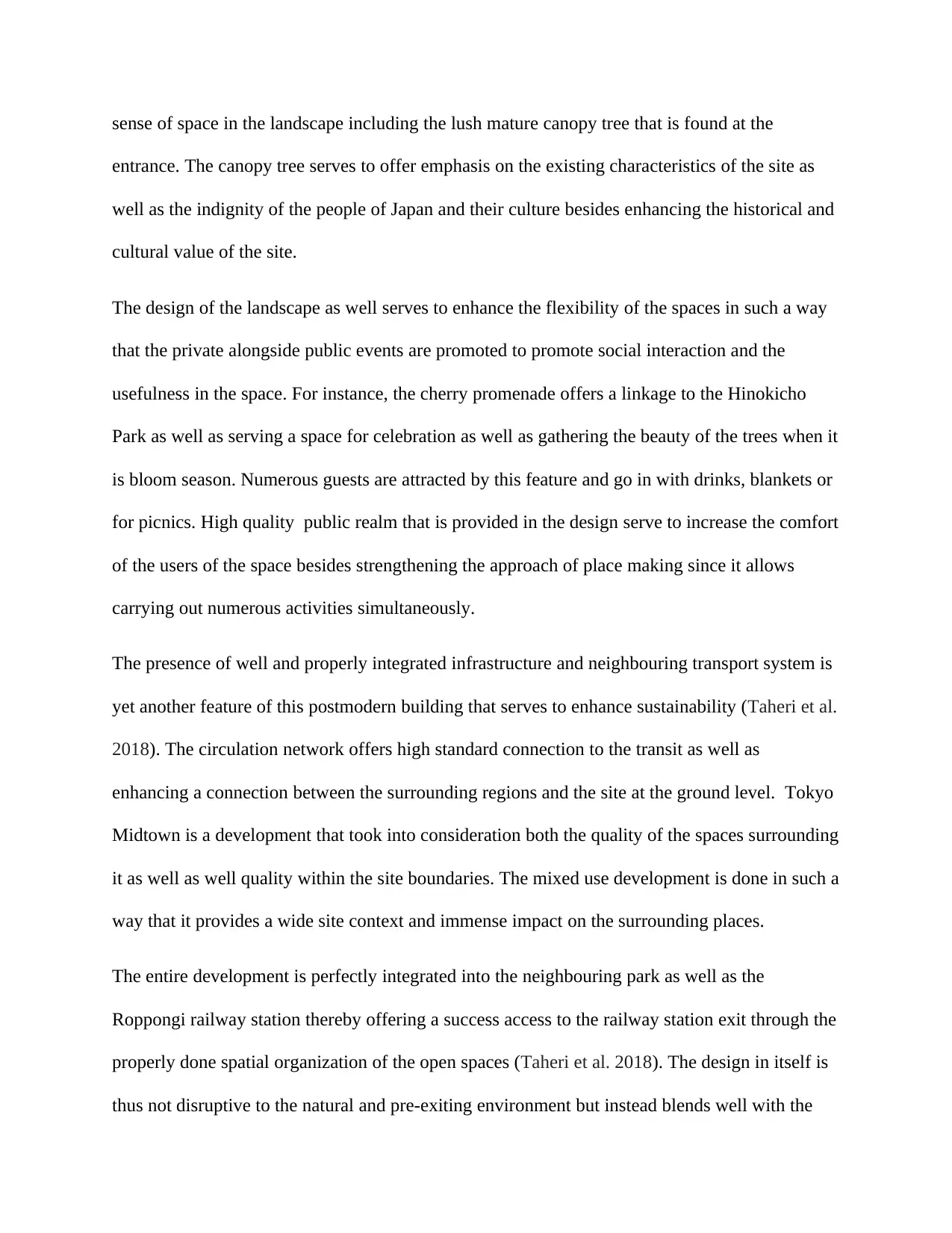
sense of space in the landscape including the lush mature canopy tree that is found at the
entrance. The canopy tree serves to offer emphasis on the existing characteristics of the site as
well as the indignity of the people of Japan and their culture besides enhancing the historical and
cultural value of the site.
The design of the landscape as well serves to enhance the flexibility of the spaces in such a way
that the private alongside public events are promoted to promote social interaction and the
usefulness in the space. For instance, the cherry promenade offers a linkage to the Hinokicho
Park as well as serving a space for celebration as well as gathering the beauty of the trees when it
is bloom season. Numerous guests are attracted by this feature and go in with drinks, blankets or
for picnics. High quality public realm that is provided in the design serve to increase the comfort
of the users of the space besides strengthening the approach of place making since it allows
carrying out numerous activities simultaneously.
The presence of well and properly integrated infrastructure and neighbouring transport system is
yet another feature of this postmodern building that serves to enhance sustainability (Taheri et al.
2018). The circulation network offers high standard connection to the transit as well as
enhancing a connection between the surrounding regions and the site at the ground level. Tokyo
Midtown is a development that took into consideration both the quality of the spaces surrounding
it as well as well quality within the site boundaries. The mixed use development is done in such a
way that it provides a wide site context and immense impact on the surrounding places.
The entire development is perfectly integrated into the neighbouring park as well as the
Roppongi railway station thereby offering a success access to the railway station exit through the
properly done spatial organization of the open spaces (Taheri et al. 2018). The design in itself is
thus not disruptive to the natural and pre-exiting environment but instead blends well with the
entrance. The canopy tree serves to offer emphasis on the existing characteristics of the site as
well as the indignity of the people of Japan and their culture besides enhancing the historical and
cultural value of the site.
The design of the landscape as well serves to enhance the flexibility of the spaces in such a way
that the private alongside public events are promoted to promote social interaction and the
usefulness in the space. For instance, the cherry promenade offers a linkage to the Hinokicho
Park as well as serving a space for celebration as well as gathering the beauty of the trees when it
is bloom season. Numerous guests are attracted by this feature and go in with drinks, blankets or
for picnics. High quality public realm that is provided in the design serve to increase the comfort
of the users of the space besides strengthening the approach of place making since it allows
carrying out numerous activities simultaneously.
The presence of well and properly integrated infrastructure and neighbouring transport system is
yet another feature of this postmodern building that serves to enhance sustainability (Taheri et al.
2018). The circulation network offers high standard connection to the transit as well as
enhancing a connection between the surrounding regions and the site at the ground level. Tokyo
Midtown is a development that took into consideration both the quality of the spaces surrounding
it as well as well quality within the site boundaries. The mixed use development is done in such a
way that it provides a wide site context and immense impact on the surrounding places.
The entire development is perfectly integrated into the neighbouring park as well as the
Roppongi railway station thereby offering a success access to the railway station exit through the
properly done spatial organization of the open spaces (Taheri et al. 2018). The design in itself is
thus not disruptive to the natural and pre-exiting environment but instead blends well with the
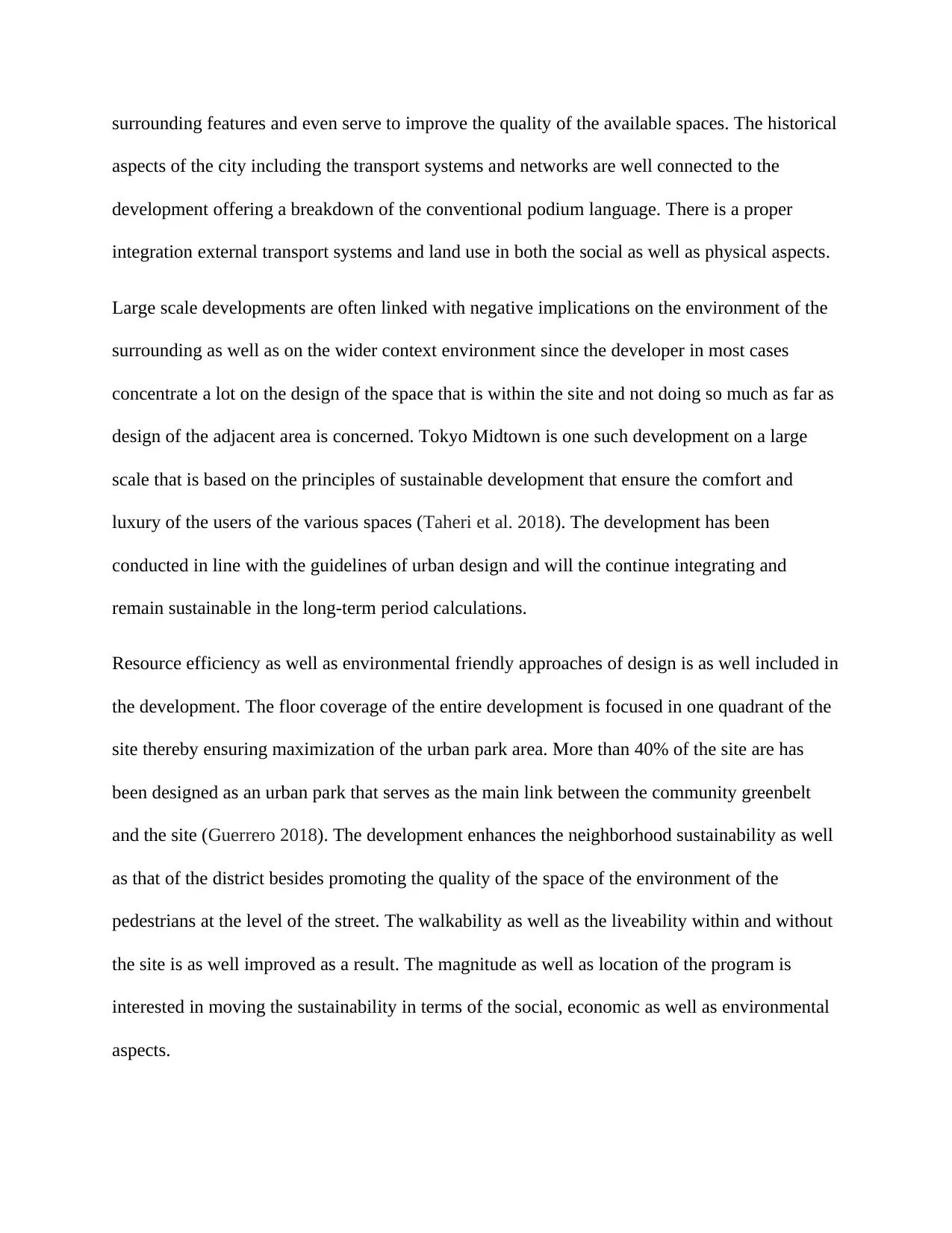
surrounding features and even serve to improve the quality of the available spaces. The historical
aspects of the city including the transport systems and networks are well connected to the
development offering a breakdown of the conventional podium language. There is a proper
integration external transport systems and land use in both the social as well as physical aspects.
Large scale developments are often linked with negative implications on the environment of the
surrounding as well as on the wider context environment since the developer in most cases
concentrate a lot on the design of the space that is within the site and not doing so much as far as
design of the adjacent area is concerned. Tokyo Midtown is one such development on a large
scale that is based on the principles of sustainable development that ensure the comfort and
luxury of the users of the various spaces (Taheri et al. 2018). The development has been
conducted in line with the guidelines of urban design and will the continue integrating and
remain sustainable in the long-term period calculations.
Resource efficiency as well as environmental friendly approaches of design is as well included in
the development. The floor coverage of the entire development is focused in one quadrant of the
site thereby ensuring maximization of the urban park area. More than 40% of the site are has
been designed as an urban park that serves as the main link between the community greenbelt
and the site (Guerrero 2018). The development enhances the neighborhood sustainability as well
as that of the district besides promoting the quality of the space of the environment of the
pedestrians at the level of the street. The walkability as well as the liveability within and without
the site is as well improved as a result. The magnitude as well as location of the program is
interested in moving the sustainability in terms of the social, economic as well as environmental
aspects.
aspects of the city including the transport systems and networks are well connected to the
development offering a breakdown of the conventional podium language. There is a proper
integration external transport systems and land use in both the social as well as physical aspects.
Large scale developments are often linked with negative implications on the environment of the
surrounding as well as on the wider context environment since the developer in most cases
concentrate a lot on the design of the space that is within the site and not doing so much as far as
design of the adjacent area is concerned. Tokyo Midtown is one such development on a large
scale that is based on the principles of sustainable development that ensure the comfort and
luxury of the users of the various spaces (Taheri et al. 2018). The development has been
conducted in line with the guidelines of urban design and will the continue integrating and
remain sustainable in the long-term period calculations.
Resource efficiency as well as environmental friendly approaches of design is as well included in
the development. The floor coverage of the entire development is focused in one quadrant of the
site thereby ensuring maximization of the urban park area. More than 40% of the site are has
been designed as an urban park that serves as the main link between the community greenbelt
and the site (Guerrero 2018). The development enhances the neighborhood sustainability as well
as that of the district besides promoting the quality of the space of the environment of the
pedestrians at the level of the street. The walkability as well as the liveability within and without
the site is as well improved as a result. The magnitude as well as location of the program is
interested in moving the sustainability in terms of the social, economic as well as environmental
aspects.
⊘ This is a preview!⊘
Do you want full access?
Subscribe today to unlock all pages.

Trusted by 1+ million students worldwide
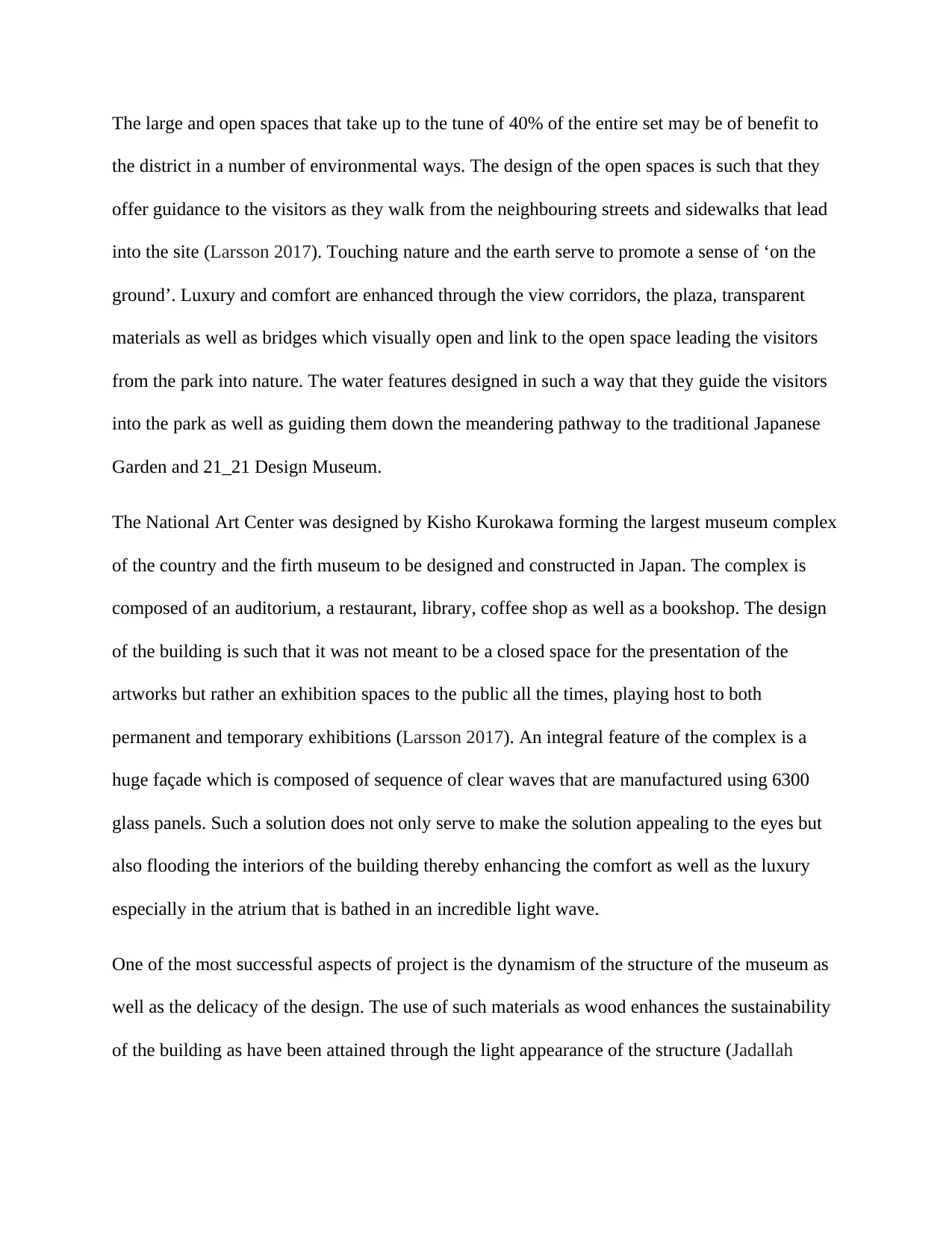
The large and open spaces that take up to the tune of 40% of the entire set may be of benefit to
the district in a number of environmental ways. The design of the open spaces is such that they
offer guidance to the visitors as they walk from the neighbouring streets and sidewalks that lead
into the site (Larsson 2017). Touching nature and the earth serve to promote a sense of ‘on the
ground’. Luxury and comfort are enhanced through the view corridors, the plaza, transparent
materials as well as bridges which visually open and link to the open space leading the visitors
from the park into nature. The water features designed in such a way that they guide the visitors
into the park as well as guiding them down the meandering pathway to the traditional Japanese
Garden and 21_21 Design Museum.
The National Art Center was designed by Kisho Kurokawa forming the largest museum complex
of the country and the firth museum to be designed and constructed in Japan. The complex is
composed of an auditorium, a restaurant, library, coffee shop as well as a bookshop. The design
of the building is such that it was not meant to be a closed space for the presentation of the
artworks but rather an exhibition spaces to the public all the times, playing host to both
permanent and temporary exhibitions (Larsson 2017). An integral feature of the complex is a
huge façade which is composed of sequence of clear waves that are manufactured using 6300
glass panels. Such a solution does not only serve to make the solution appealing to the eyes but
also flooding the interiors of the building thereby enhancing the comfort as well as the luxury
especially in the atrium that is bathed in an incredible light wave.
One of the most successful aspects of project is the dynamism of the structure of the museum as
well as the delicacy of the design. The use of such materials as wood enhances the sustainability
of the building as have been attained through the light appearance of the structure (Jadallah
the district in a number of environmental ways. The design of the open spaces is such that they
offer guidance to the visitors as they walk from the neighbouring streets and sidewalks that lead
into the site (Larsson 2017). Touching nature and the earth serve to promote a sense of ‘on the
ground’. Luxury and comfort are enhanced through the view corridors, the plaza, transparent
materials as well as bridges which visually open and link to the open space leading the visitors
from the park into nature. The water features designed in such a way that they guide the visitors
into the park as well as guiding them down the meandering pathway to the traditional Japanese
Garden and 21_21 Design Museum.
The National Art Center was designed by Kisho Kurokawa forming the largest museum complex
of the country and the firth museum to be designed and constructed in Japan. The complex is
composed of an auditorium, a restaurant, library, coffee shop as well as a bookshop. The design
of the building is such that it was not meant to be a closed space for the presentation of the
artworks but rather an exhibition spaces to the public all the times, playing host to both
permanent and temporary exhibitions (Larsson 2017). An integral feature of the complex is a
huge façade which is composed of sequence of clear waves that are manufactured using 6300
glass panels. Such a solution does not only serve to make the solution appealing to the eyes but
also flooding the interiors of the building thereby enhancing the comfort as well as the luxury
especially in the atrium that is bathed in an incredible light wave.
One of the most successful aspects of project is the dynamism of the structure of the museum as
well as the delicacy of the design. The use of such materials as wood enhances the sustainability
of the building as have been attained through the light appearance of the structure (Jadallah
Paraphrase This Document
Need a fresh take? Get an instant paraphrase of this document with our AI Paraphraser
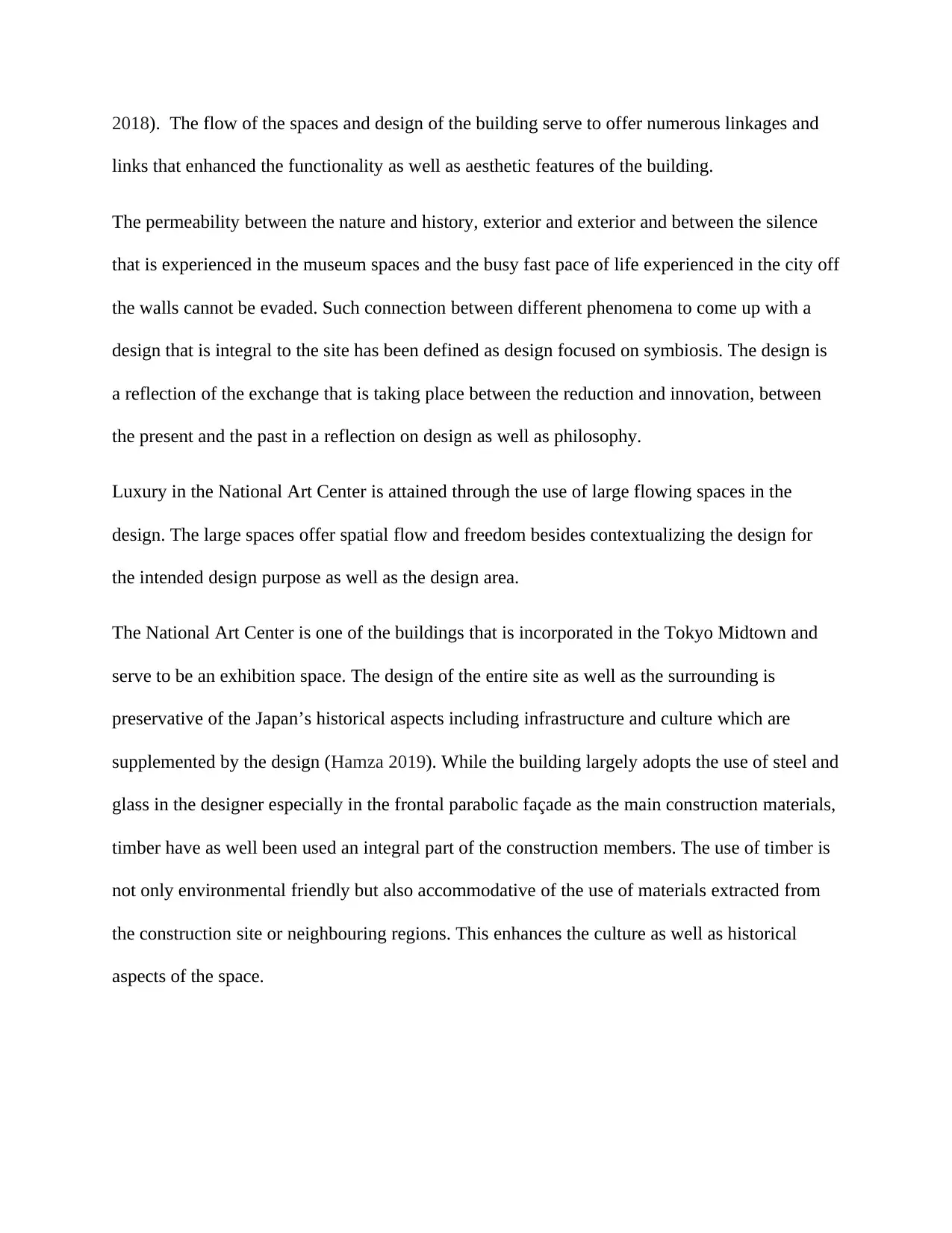
2018). The flow of the spaces and design of the building serve to offer numerous linkages and
links that enhanced the functionality as well as aesthetic features of the building.
The permeability between the nature and history, exterior and exterior and between the silence
that is experienced in the museum spaces and the busy fast pace of life experienced in the city off
the walls cannot be evaded. Such connection between different phenomena to come up with a
design that is integral to the site has been defined as design focused on symbiosis. The design is
a reflection of the exchange that is taking place between the reduction and innovation, between
the present and the past in a reflection on design as well as philosophy.
Luxury in the National Art Center is attained through the use of large flowing spaces in the
design. The large spaces offer spatial flow and freedom besides contextualizing the design for
the intended design purpose as well as the design area.
The National Art Center is one of the buildings that is incorporated in the Tokyo Midtown and
serve to be an exhibition space. The design of the entire site as well as the surrounding is
preservative of the Japan’s historical aspects including infrastructure and culture which are
supplemented by the design (Hamza 2019). While the building largely adopts the use of steel and
glass in the designer especially in the frontal parabolic façade as the main construction materials,
timber have as well been used an integral part of the construction members. The use of timber is
not only environmental friendly but also accommodative of the use of materials extracted from
the construction site or neighbouring regions. This enhances the culture as well as historical
aspects of the space.
links that enhanced the functionality as well as aesthetic features of the building.
The permeability between the nature and history, exterior and exterior and between the silence
that is experienced in the museum spaces and the busy fast pace of life experienced in the city off
the walls cannot be evaded. Such connection between different phenomena to come up with a
design that is integral to the site has been defined as design focused on symbiosis. The design is
a reflection of the exchange that is taking place between the reduction and innovation, between
the present and the past in a reflection on design as well as philosophy.
Luxury in the National Art Center is attained through the use of large flowing spaces in the
design. The large spaces offer spatial flow and freedom besides contextualizing the design for
the intended design purpose as well as the design area.
The National Art Center is one of the buildings that is incorporated in the Tokyo Midtown and
serve to be an exhibition space. The design of the entire site as well as the surrounding is
preservative of the Japan’s historical aspects including infrastructure and culture which are
supplemented by the design (Hamza 2019). While the building largely adopts the use of steel and
glass in the designer especially in the frontal parabolic façade as the main construction materials,
timber have as well been used an integral part of the construction members. The use of timber is
not only environmental friendly but also accommodative of the use of materials extracted from
the construction site or neighbouring regions. This enhances the culture as well as historical
aspects of the space.
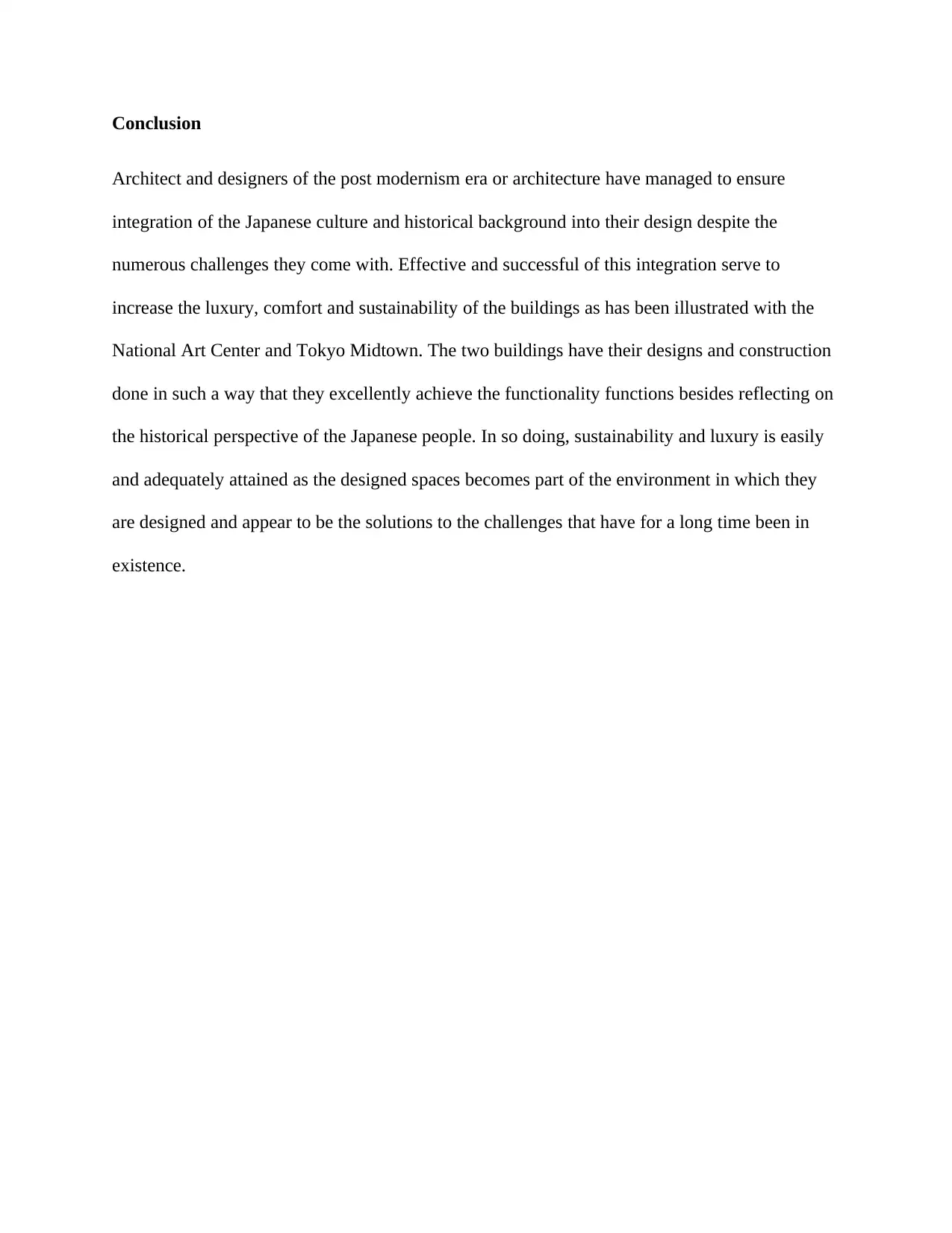
Conclusion
Architect and designers of the post modernism era or architecture have managed to ensure
integration of the Japanese culture and historical background into their design despite the
numerous challenges they come with. Effective and successful of this integration serve to
increase the luxury, comfort and sustainability of the buildings as has been illustrated with the
National Art Center and Tokyo Midtown. The two buildings have their designs and construction
done in such a way that they excellently achieve the functionality functions besides reflecting on
the historical perspective of the Japanese people. In so doing, sustainability and luxury is easily
and adequately attained as the designed spaces becomes part of the environment in which they
are designed and appear to be the solutions to the challenges that have for a long time been in
existence.
Architect and designers of the post modernism era or architecture have managed to ensure
integration of the Japanese culture and historical background into their design despite the
numerous challenges they come with. Effective and successful of this integration serve to
increase the luxury, comfort and sustainability of the buildings as has been illustrated with the
National Art Center and Tokyo Midtown. The two buildings have their designs and construction
done in such a way that they excellently achieve the functionality functions besides reflecting on
the historical perspective of the Japanese people. In so doing, sustainability and luxury is easily
and adequately attained as the designed spaces becomes part of the environment in which they
are designed and appear to be the solutions to the challenges that have for a long time been in
existence.
⊘ This is a preview!⊘
Do you want full access?
Subscribe today to unlock all pages.

Trusted by 1+ million students worldwide
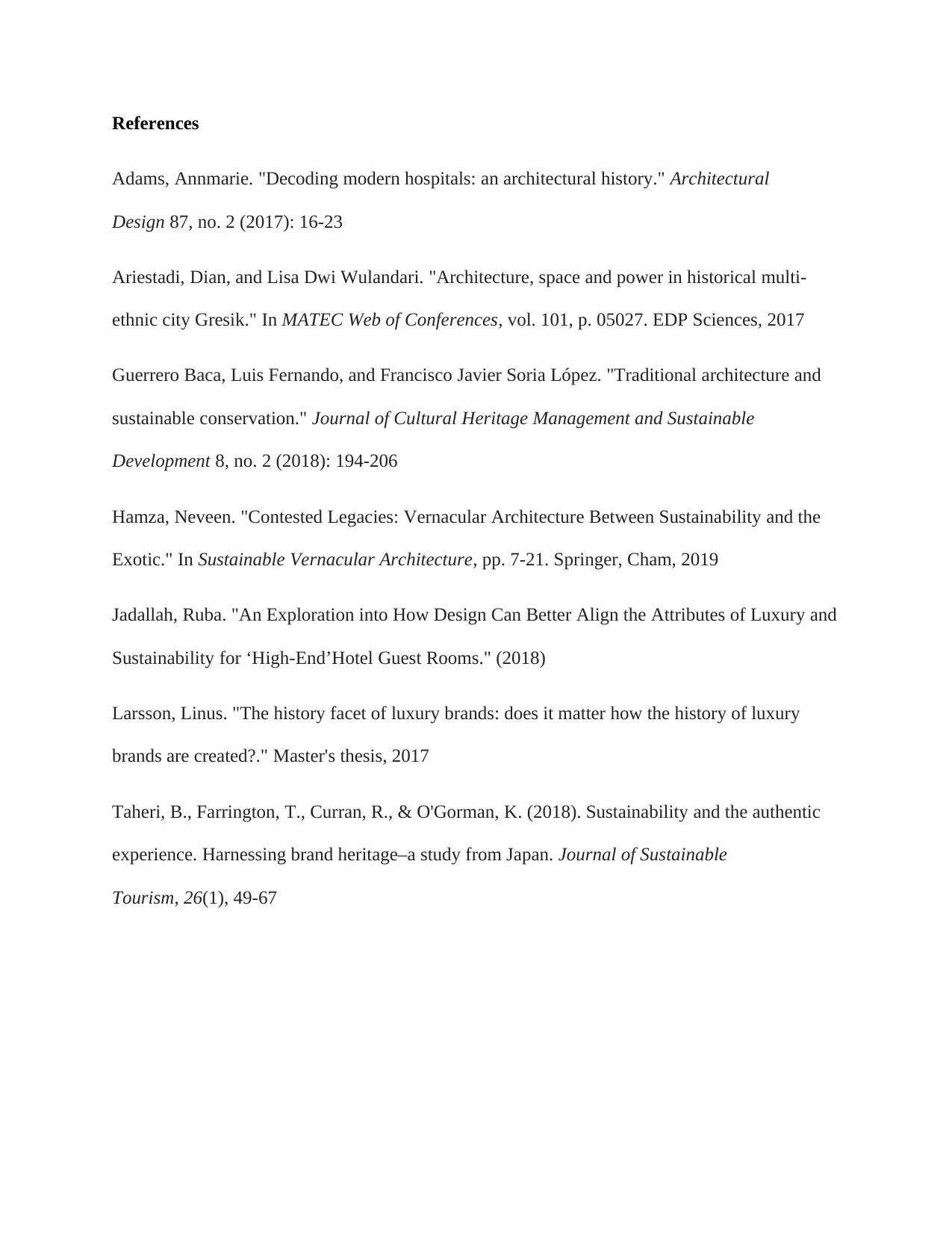
References
Adams, Annmarie. "Decoding modern hospitals: an architectural history." Architectural
Design 87, no. 2 (2017): 16-23
Ariestadi, Dian, and Lisa Dwi Wulandari. "Architecture, space and power in historical multi-
ethnic city Gresik." In MATEC Web of Conferences, vol. 101, p. 05027. EDP Sciences, 2017
Guerrero Baca, Luis Fernando, and Francisco Javier Soria López. "Traditional architecture and
sustainable conservation." Journal of Cultural Heritage Management and Sustainable
Development 8, no. 2 (2018): 194-206
Hamza, Neveen. "Contested Legacies: Vernacular Architecture Between Sustainability and the
Exotic." In Sustainable Vernacular Architecture, pp. 7-21. Springer, Cham, 2019
Jadallah, Ruba. "An Exploration into How Design Can Better Align the Attributes of Luxury and
Sustainability for ‘High-End’Hotel Guest Rooms." (2018)
Larsson, Linus. "The history facet of luxury brands: does it matter how the history of luxury
brands are created?." Master's thesis, 2017
Taheri, B., Farrington, T., Curran, R., & O'Gorman, K. (2018). Sustainability and the authentic
experience. Harnessing brand heritage–a study from Japan. Journal of Sustainable
Tourism, 26(1), 49-67
Adams, Annmarie. "Decoding modern hospitals: an architectural history." Architectural
Design 87, no. 2 (2017): 16-23
Ariestadi, Dian, and Lisa Dwi Wulandari. "Architecture, space and power in historical multi-
ethnic city Gresik." In MATEC Web of Conferences, vol. 101, p. 05027. EDP Sciences, 2017
Guerrero Baca, Luis Fernando, and Francisco Javier Soria López. "Traditional architecture and
sustainable conservation." Journal of Cultural Heritage Management and Sustainable
Development 8, no. 2 (2018): 194-206
Hamza, Neveen. "Contested Legacies: Vernacular Architecture Between Sustainability and the
Exotic." In Sustainable Vernacular Architecture, pp. 7-21. Springer, Cham, 2019
Jadallah, Ruba. "An Exploration into How Design Can Better Align the Attributes of Luxury and
Sustainability for ‘High-End’Hotel Guest Rooms." (2018)
Larsson, Linus. "The history facet of luxury brands: does it matter how the history of luxury
brands are created?." Master's thesis, 2017
Taheri, B., Farrington, T., Curran, R., & O'Gorman, K. (2018). Sustainability and the authentic
experience. Harnessing brand heritage–a study from Japan. Journal of Sustainable
Tourism, 26(1), 49-67
1 out of 10
Your All-in-One AI-Powered Toolkit for Academic Success.
+13062052269
info@desklib.com
Available 24*7 on WhatsApp / Email
![[object Object]](/_next/static/media/star-bottom.7253800d.svg)
Unlock your academic potential
Copyright © 2020–2025 A2Z Services. All Rights Reserved. Developed and managed by ZUCOL.

